SOMETHING FISHY'S GOING ON HERE...
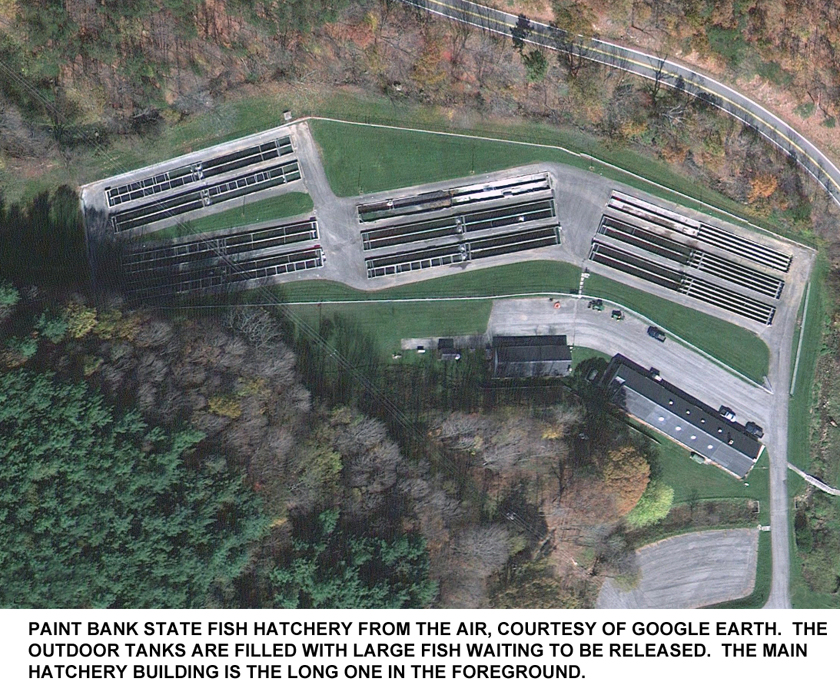
 On the day before THE SUPER BOWL!!!! I had my second stint as a member of the the DGIF's volunteer work force. I went to the fish hatchery in Paint Bank, VA, to give them a hand. Paint Bank is about as obscure a place as it can be and still have electricity. It's not really a town, it's just a wide spot in the road with a small general store, a decent country-style restaurant, and, about 4 miles outside the "town limits," the fish hatchery, which produces various flavors of trout, in prodigious quantities, to stock in the streams of the Commonwealth.
On the day before THE SUPER BOWL!!!! I had my second stint as a member of the the DGIF's volunteer work force. I went to the fish hatchery in Paint Bank, VA, to give them a hand. Paint Bank is about as obscure a place as it can be and still have electricity. It's not really a town, it's just a wide spot in the road with a small general store, a decent country-style restaurant, and, about 4 miles outside the "town limits," the fish hatchery, which produces various flavors of trout, in prodigious quantities, to stock in the streams of the Commonwealth.
The hatchery was originally built in the 1950's by the Federal government; Virginia took possession probably 20+ years ago. There are indoor and outdoor ponds, housing fish in various stages of life from eggs to "Holy Shit, I didn't think trout could get that big!" size. The mature fish—some of them weighing 5 pounds or more—are released on a weekly basis, sometimes more often in peak season.
Last month I was on a fish-stocking run, and we put 800 pounds of mature fish from this hatchery into Big Stoney Creek. Since there are several local creeks to be stocked, and since Paint Bank supplies other hatcheries that don't grow trout with some to stock in other areas, the number of fish of all sizes "in house" is simply staggering. 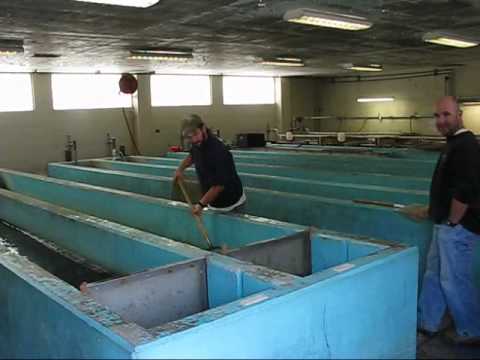
I fed fish: they get pellets in various sizes from 2mm up to about 5mm (depending on the size of the fish to be fed) scattered in the runs. Three times a day the big fish in the outside runs get something like 900 pounds of food. The indoor fish, the small ones, get fed every hour. It's not work that requires a lot of brains: just scoop up a handful, throw it in the run, and move on. The fish know exactly what's coming, too: as soon as the first pellet hits the water, there is a roiling of the previously-placid surface as they fight for the stuff. Needless to say, they're packed in pretty tightly; when you have 10,000 2- to 3-pound trout in a raceway that's maybe 60 feet long, the density is high enough to make the water look like it's coming to a boil.
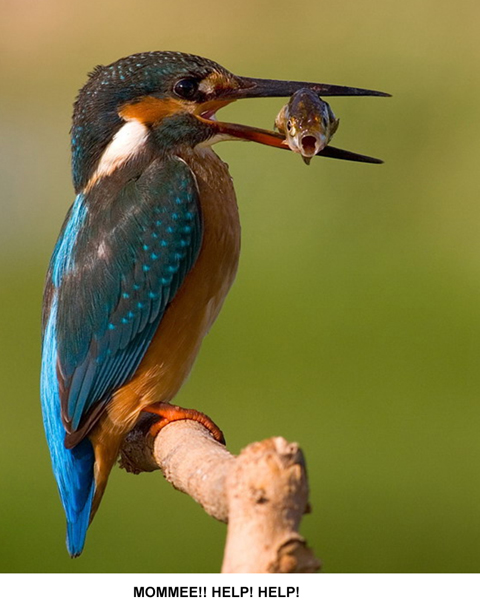 Outside tanks have issues with piscivorous birds. Herons and others like ospreys look upon the hatchery as a the gift of a bountiful Mother Nature; all the various forms of fish-eating raptors (we have eagles here, too) love the place. Ditto raccoons and some other terrestrial species, not excepting the odd featherless biped who sneaks in at night to throw a line over the boundary fence in hopes of a free trout dinner. The outdoor tanks do have a chain link fence around them but that doesn't stop some people. Birds can usually be dissuaded by a wire mesh screen over the top of the tank, but not always. Sometimes they find their way under it, and in that case the staff ends up pulling out a drowned bird.
Outside tanks have issues with piscivorous birds. Herons and others like ospreys look upon the hatchery as a the gift of a bountiful Mother Nature; all the various forms of fish-eating raptors (we have eagles here, too) love the place. Ditto raccoons and some other terrestrial species, not excepting the odd featherless biped who sneaks in at night to throw a line over the boundary fence in hopes of a free trout dinner. The outdoor tanks do have a chain link fence around them but that doesn't stop some people. Birds can usually be dissuaded by a wire mesh screen over the top of the tank, but not always. Sometimes they find their way under it, and in that case the staff ends up pulling out a drowned bird.
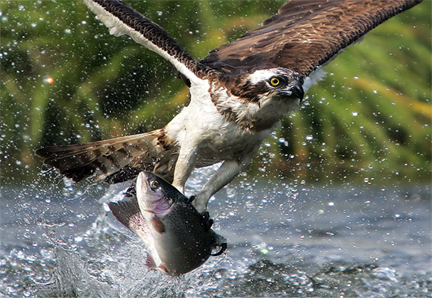 Today was an "inventory" day. Another thing I did was to help with the inventory of some of the inside tanks. These were the ones housing fingerlings in the 2-3 inch size range. Each of the 16 or so tanks held at least 25,000 fish, and there were as many more in "nearly-ready-to-release" sizes in the outside tanks. In all there are well over a quarter of a million fish in the place this time of year, when the staff is growing them up for the Spring season.
Today was an "inventory" day. Another thing I did was to help with the inventory of some of the inside tanks. These were the ones housing fingerlings in the 2-3 inch size range. Each of the 16 or so tanks held at least 25,000 fish, and there were as many more in "nearly-ready-to-release" sizes in the outside tanks. In all there are well over a quarter of a million fish in the place this time of year, when the staff is growing them up for the Spring season.
The way you count fish in these numbers is to weigh a sample and get an average weight for the size class. You do this by putting a small bucket of water on a scale, zeroing it, and then dispensing exactly half a pound of fish into the bucket. When the scale shows 0.50 pounds, you put the fish back into the tank one by one, counting them as they go in. Three weight samples (one from each end of the tank and one from the middle) get averaged. The small fish we were counting were in the 130-145 per pound size.
At that point the whole tank population has to be weighed. This is done the same way on a larger scale. A movable screen is used to chivvy the fish into a small area of the tank; then netfuls are scooped out and weighed in a washtub that's been half-filled with water and zeroed out, just as the small bucket was. Typically there will be 10-15 pounds per netful. Once the fish in a netful have been weighed they go back in the tank (behind the barricade screen) and the next netful is weighed. Using the average number of fish per pound, it's simple arithmetic to count the total numbers of individual fish, which came to 22,000 to 25,000 per tank. I asked if there were a less labor intensive way to do it, and was told, "Yes, but we don't have the money to buy the equipment."
In addition to the birds and raccoons and other predators, there are losses in handling and stress. Sweeping a screen through a tank of fingerlings from one end to another kills a number of them each time, but given the enormous numbers involved it's a minuscule percentage. I don't know what the overall margin for error in their weight sampling method may, but given the numbers of individual fish involved it's probably not too much. I remarked that they could probably make their budget go farther by freezing and selling the deaders as bait, but was told the Commonwealth would disapprove of selling Official Commonwealth-Government-Issue fish. Oh, well.
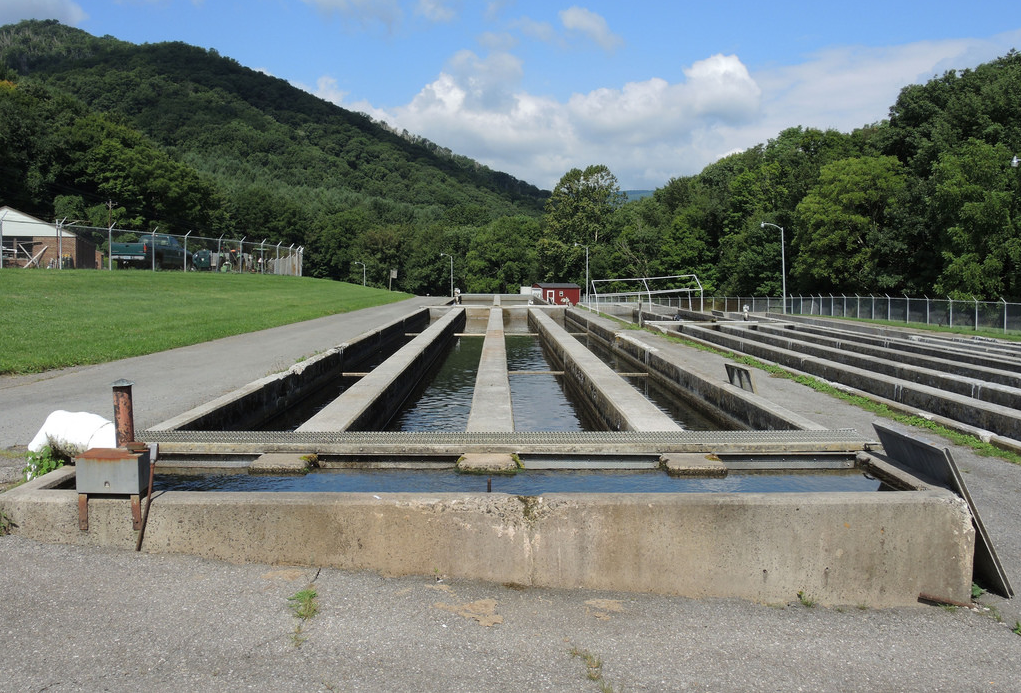
The place uses staggering amounts of water. Amazingly, isn't recirculated: it comes direct from three springs on the property and I was told their water consumption was 1500 gallons per MINUTE. The water makes one pass through the tanks and into the drains to go into the nearby creek. In four minutes this place consumes as much water as we use in my house in a month!
Recirculating aquaculture systems do exist but they're expensive and not so good as the single-pass type. The spring water is at a constant temperature of 55 degrees Fahrenheit coming out of the springs. It's clean and well oxygenated, but fish in those numbers use a lot of oxygen; the hatchery has installed oxygen pumps that run all the time to keep the oxygen level well up and minimize mortality. I was told they're shortly going to switch over to a liquid oxygen injection system, which they use for small tanks on the stocking trucks.
I also did a little painting of steel bars that were to be used to make more bird screens, and other odds and ends.
It was a COLD day, colder than Hillary Clinton's heart. And I managed to pull off a truly boneheaded maneuver that could have killed me and while it didn't, it's left me wondering how much time I have left before senility finally strikes me down. I had left the house with a generous margin of time to allow me to find the place (it's 53 miles away). After locating it, I went a few miles beyond on the "Virginia Byway" of Route 311, to see what I could see. Not much: once you get past Paint Bank it's all National Forest, more or less, until you hit West Virginia. Nice country but nobody lives there. Craig County has a total population of about 5200 people. Paint Bank is unincorporated and according to the "Sperling's Best Places" web site, it has a population of 27 people. Beautiful area but a whole lot of not much of anything else out there.
At one point along my meandering I pulled over to "see what I could pee," if you catch my meaning. When I went to get back into the truck...the doors were locked! I was locked out of my vehicle, at perhaps 16 degrees Fahrenheit, miles from civilization, and my sweater and jacket were locked in the truck, which was of course still running.
The truck has automatic door locks and I must have hit the button with my elbow getting out. So there I was, freezing my ass off—did I mention the wind was blowing to beat the band?—at 7:00 AM on top of Potts Mountain (elevation 3450 feet) in a place where maybe 3 cars come by each day. Did I have a spare key stashed under the bumper? Nope. Why not? Because the keys have a coded microchip in them and spares can be had only at a dealership, for $120 EACH.
I thought I was going to have to dismount the trailer hitch and smash a window. Fortunately I had a phone signal, so I called 911. In about 45 minutes an elderly Craig County Sheriff's deputy came by, shoved a plastic wedge in the door, and snaked in a long piece of metal rod, with which he was able to push the door lock button and let me in. Had I not had a phone signal, or had I forgotten my phone, I likely would now be a frozen corpse in the truck bed, where I was taking what shelter I could find from the wind.
The first thing I did when I got home was to get a key made at the hardware store. It won't start the engine—no chip—but it will open the door next time I'm dumb enough to lock myself out.

I probably will be called back again from time to time: stream-stocking season begins in earnest in a few weeks. As one of the workers remarked, "Well, you've seen it at the worst; after this the weather can only get better."
| HUNTING | GUNS | DOGS |
| FISHING & BOATING | TRIP REPORTS | MISCELLANEOUS ESSAYS |
| CONTRIBUTIONS FROM OTHER WRITERS|
| RECIPES |POLITICS |